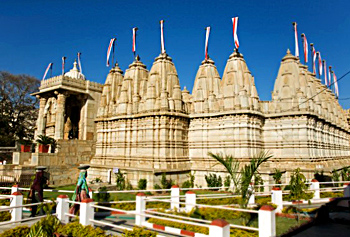 Tower or Vimana is a major feature of Jain Architecture in North India. Two most important towers in Chittorgarh reveals the basic Jain architecture: Kirti Stambha" (Tower of Fame) and the other is called "Jaya Stambha" (Tower of Victory). The tower has seven stories on the basement. The top floor is an observation hall from which one can have a view of the inside the citadel, surrounding plains and the horizon. It is dedicated to the first Tirthankara (Jina) Adinatha. Its formation is unique. It has complicated formations: it is covered with carvings of the statues of Jina, has a streak of combination of narrow and thick parts and shaded by positions and balconies.
Tower or Vimana is a major feature of Jain Architecture in North India. Two most important towers in Chittorgarh reveals the basic Jain architecture: Kirti Stambha" (Tower of Fame) and the other is called "Jaya Stambha" (Tower of Victory). The tower has seven stories on the basement. The top floor is an observation hall from which one can have a view of the inside the citadel, surrounding plains and the horizon. It is dedicated to the first Tirthankara (Jina) Adinatha. Its formation is unique. It has complicated formations: it is covered with carvings of the statues of Jina, has a streak of combination of narrow and thick parts and shaded by positions and balconies.
The tower has a spacious interior and one can climb up without bending their bodies. There are two concentric squared walls. Then again we go up the central spiral staircase.
Sacred images are carved in the corridors and each ceiling is elaborately engraved at the top of each spiral staircase. The Tower of Victory is larger than the Tower of Fame. Its design is monotonous. The tower is dedicated to Lord Vishnu. From architectural point of view there is not much difference.
Both two towers in Chittorgarh are called "stambhas," and actually the term "stambha" represents a pillar, in particular a memorial one. The Satbis Deori temple in the citadel of Chittorgarh was built based on the same style as temples on Mt. Abu. The exterior of garbhagriha shows a distinctive Northern Style.
The image in a Jain temple is always placed in a square cell. It seems to be a rule that the presence and position of the main idol should be indicated externally by a tower as well as it has a curved outline. The upper part of sikra overhangs the base and bends inwards toward the top. The northern Jaina style is seen at Palatina and Girnar, in Gujarat and at Mount Abu and at Parswanath in the highest point of Bengal range of hills to the south of Rajmahal. There are ruins of Jain temples at Gwalior, at Khajuraho, at Gyraspore, near Bhilsa, in Central India, at Amwah, near Ajanta and at Chitore, in Rajputana, where the noble nine-storeyed pagoda was erected as a jaya stambha to commemorate the victory of the Rajput raja Khambo over Mahmud of Malwa. Another Jaina structure can be found at The Indra cave at Ellora which was built A.D. 750. Examples of Modern Jaina temples are visible at Sonaghur, in Bandelkhand at Delhi and at Ahmedabad in Gujarat.



















